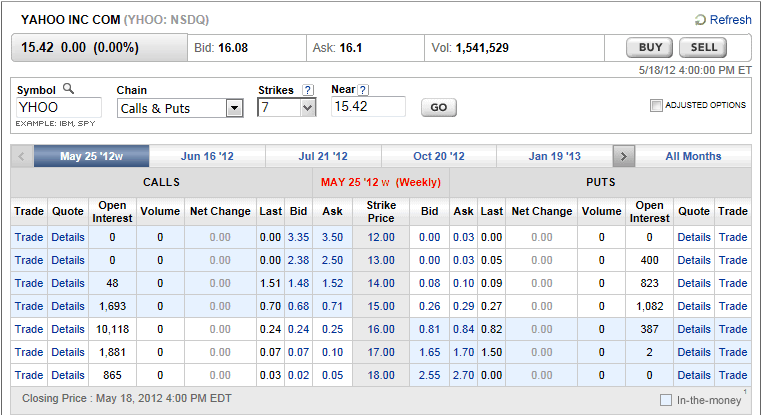Call Option Definition Example
Post on: 9 Июль, 2015 No Comment

What it is:
A call option gives the holder the right, but not the obligation. to purchase 100 shares of a particular underlying stock at a specified strike price on the option ‘s expiration date.
How it works/Example:
Options are derivative instruments, meaning that their prices are derived from the price of another security. More specifically, options prices are derived from the price of an underlying stock. For example, let’s say you purchase a call option on shares of Intel (INTC) with a strike price of $40 and an expiration date of April 16th. This option would give you the right to purchase 100 shares of Intel at a price of $40 on April 16th (the right to do this, of course, will only be valuable if Intel is trading above $40 per share at that point in time). Note that the expiration date always falls on the third Friday of the month in which the option is scheduled to expire.
Every option represents a contract between a buyer and seller. The seller (writer) has the obligation to either buy or sell stock (depending on what type of option he or she sold; either a call option or a put option ) to the buyer at a specified price by a specified date. Meanwhile, the buyer of an option contract has the right, but not the obligation, to complete the transaction by a specified date. When an option expires, if it is not in the buyer’s best interest to exercise the option, then he or she is not obligated to do anything. The buyer has purchased the option to carry out a certain transaction in the future, hence the name.
As a quick example of how call options make money. let’s say IBM stock is currently trading at $100 per share. Now let’s say an investor purchases one call option contract on IBM with a $100 strike and at a price of $2.00 per contract. Note: Because each options contract represents an interest in 100 underlying shares of stock, the actual cost of this option will be $200 (100 shares x $2.00 = $200).
Here’s what will happen to the value of this call option under a variety of different scenarios:
When the option expires, IBM is trading at $105.
Remember: The call option gives the buyer the right to purchase shares of IBM at $100 per share. In this scenario, the buyer could use the option to purchase those shares at $100, then immediately sell those same shares in the open market for $105. This option is therefore called in the money. Because of this, the option will sell for $5.00 on the expiration date (because each option represents an interest in 100 underlying shares, this will amount to a total sale price of $500). Because the investor purchased this option for $200, the net profit to the buyer from this trade will be $300.
When the option expires, IBM is trading at $101.
Using the same analysis as shown above, the call option will now be worth $1 (or $100 total). Since the investor spent $200 to purchase the option in the first place, he or she will show a net loss on this trade of $1.00 (or $100 total). This option would be called at the money because the transaction is essentially a wash .
When the option expires, IBM is trading at or below $100.
If IBM ends up at or below $100 on the option’s expiration date, then the contract will expire out of the money. It will now be worthless, so the option buyer will lose 100% of his or her money (in this case, the full $200 that he or she spent for the option).














